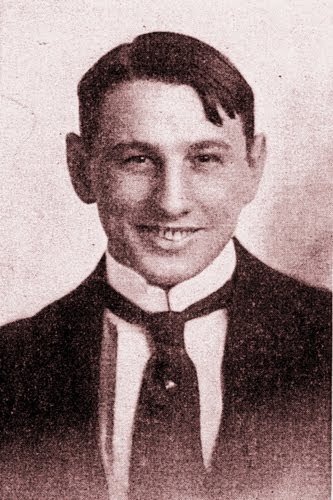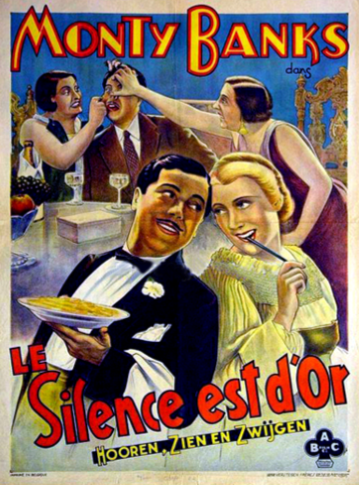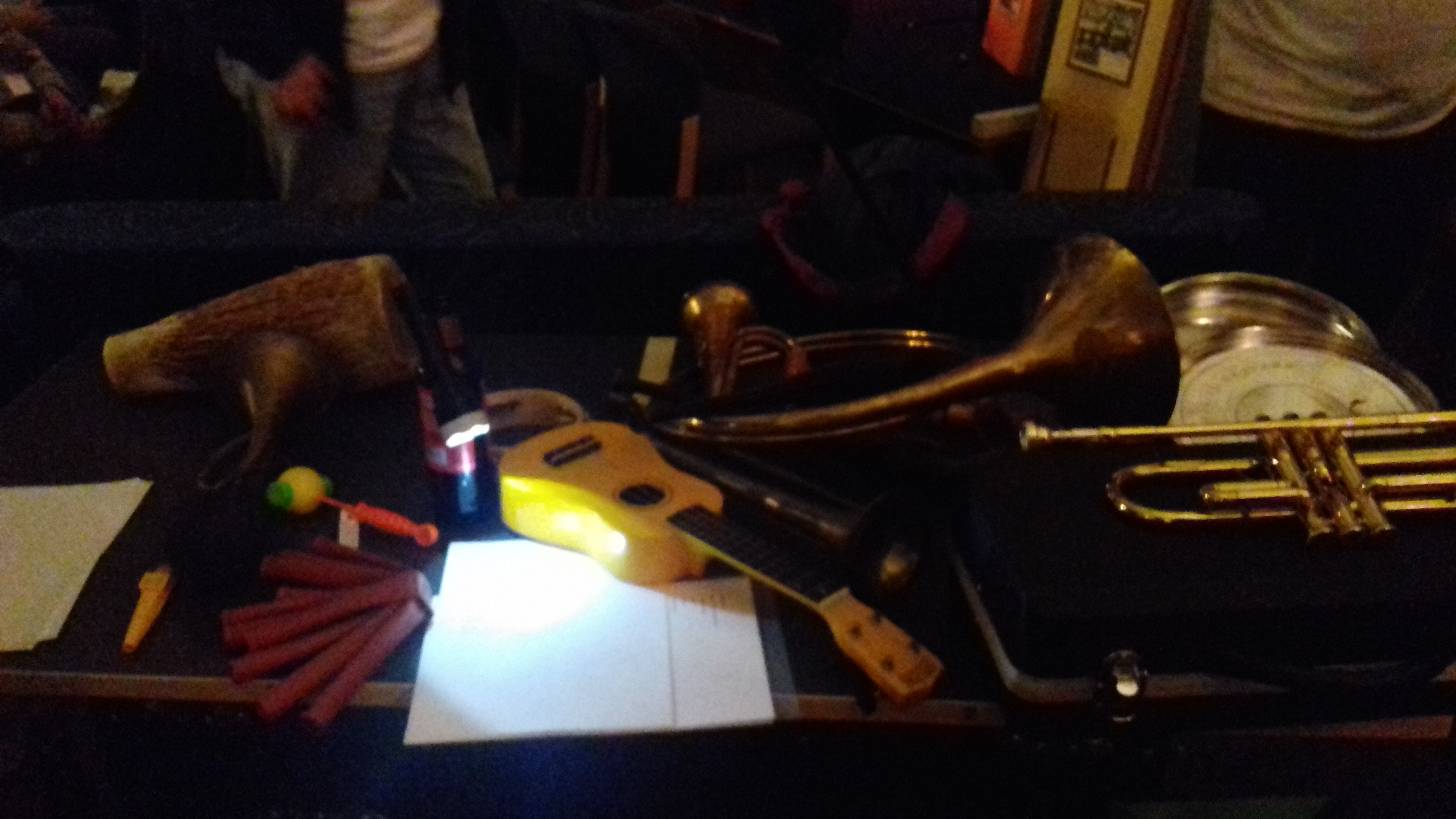
As we reach the point in the pandemic where anniversaries are being reported, a series of grim milestones remind us how long we’ve been dealing with all this. A more positive flipside of this is that many of the new initiatives and innovations that have managed to bring some sunshine into our lives are celebrating anniversaries of their own. The way we socialise and enjoy entertainment has completely been transformed in the last twelve months, and although some doors have shut, others have opened up new worlds of possibilities.
For silent film fans, the void seemed especially hard to fill. The whole essence of silent cinema revival usually centres around the live experience, after all. Silent comedy, in particular, needs an audience so that the viewer can roll on a wave of giggles and chortles. Laughter is always best when it is shared.
In March last year, the first episode of the nascent Silent Comedy Watch Party was aired. It couldn’t bring film fans together physically, but it could reproduce that feeling of an event, a shared experience. Quickly it became a huge success, uniting silent comedy fans and helping them to feel like they were sharing their laughter with others. Now, a year later the show’s hosts Ben Model and Steve Massa are just about to celebrate its one year anniversary. With the 50th Watch Party beckoning on Sunday, it has become so much more than just a live stream!
The idea of the show began when Ben returned from performing a weekend of shows in Nebraska and watched all his upcoming gigs for 2020 promptly get cancelled:
“Although I’d had the idea and tech to pull this off for some time,” says Model, “I hadn’t had a strong motivation to make a silent film show happen as a live-stream…but now there was a humanitarian need for this. I thought of all the people who could use a really good laugh to deal with the shutdown, the fear and stress of the pandemic, and not knowing when it would end. I called up Steve [Massa] about my idea for The Silent Comedy Watch Party, and we agreed this would be a great way to help people out.”
Laughter is the best medicine, after all, and coupled to the warm, community feeling of the events, the Watch Parties began to mean a great deal. Often they have been the highlight of empty or anxious weeks as the pandemic progressed. Although family commitments have meant I haven’t been able to catch every episode live, I’ve watched every single one thanks to the archive of shows on YouTube.
As the show’s press release reveals, “Messages, which came in over email and social media after the first live-stream, were full of gratitude for providing relief from the pandemic stress and for bringing viewers much-needed laughter. This has continued to be the case every week, with stories of families gathering to watch, spouses who’d never given the silents the time of day becoming fans, while other viewers told of how the show had helped them get through personal dark times and recovery from illnesses. “This is what gets me through the week” is a frequent comment Model sees about the show. During a period when days all run together, it’s become a weekly anchor of appointment TV for the 400-600 people who watch together, virtually, during the live-stream and the 1,500-3,000 people who watch the archived shows during the days after the stream.“
It’s not just the spirit of being at a live cinema event that’s being recreated, but something bigger, something global that silent film events have never been before. Now silent comedy fans from around the world who would never attend the same event in pre-COVID times can join in the fun together. Many of the films are rarities, from archives or obscure DVD releases and there are many that the viewers haven’t seen before, increasing that shared experience. In a way what we’re actually getting is something that brings us closer still to the original shared experience of silent cinema-going; seeing these films for the first time, and talking about them at the same time. I’ve really loved having chats with friends around the world each week about films that have just been screened, or seeing message boards and social media lighting up in praise of performers like Snub Pollard, Wanda Wiley or Charley Chase.
The celebration of these overlooked performers is one of the real highlights of the series of shows. Again, it creates something comparable to the original silent film experience; in the 1920s, it wouldn’t have been Keaton or Chaplin every week, but the likes of Bobby Dunn, Alice Howell, Paul Parrott or Joe Rock who filled the programmes at cinemas. It’s fantastic to see these kind of performers, so often overlooked by live cinema events, getting the most exposure that they’ve had in years. Quite naturally, live silent events often skew to the classic films, and while there are some great events showcasing rarities, it’s not often that you get such deep dives into the substrata of silent comedy. The global audience offered by the internet means that “will there be an audience for such obscure films?” is not a concern in the same way. We’ve seen a terrific slew of events, webinars and online festivals benefit from this over the last year, and on the punter side, it’s wonderful to be able to attend events that I’d always dreamed of without travelling across the world (I never did make it to a Slapsticon, to my eternal regret).
Of course, another advantage has been the ability to bring in guest hosts from around the world. The list of Silent Comedy watch Party contributors includes Suzanne Lloyd, grand-daughter of Harold Lloyd; Library of Congress curators, Rob Stone and Rachel Del Gaudio; Elif Rongen-Kaynakci from the EYE Filmmuseum in the Netherlands; and filmmaker and artist, Ina Archer who is also a media conservator for the Smithsonian’s National Museum of African American History and Culture.
Though undoubtedly we have missed out on the beauty of real world big screen events this year, we have gained something too. The Silent Comedy Watch Parties are a prime example of this and continue to be a real source of fun and inspiration. Congratulations to Ben & Steve for reaching their 50th show, and a big thanks for helping to make the last year miles better for silent comedy fans than it had any right to be. See you at the Watch Party on Sunday!
The first-anniversary show of “THE SILENT COMEDY WATCH PARTY” will live-stream on March 21, 2021, and will include the films: AN EYE FOR FIGURES (1920) with Hank Mann, shown on the very first episode; THE FADE-AWAY (1925), a Fleischer cartoon with Ko-Ko the clown, shown on episode 2, and QUEEN OF ACES (1925) starring Wanda Wiley, one of the forgotten funny ladies of silent films who’s become an SCWP fan favorite. Here’s the link to watch: The Silent Comedy Watch Party ep. 50 – 3/21/21 – Ben Model and Steve Massa – 1-year anniversary! – YouTube The show begins at 3PM EDT (that’s 7PM GMT ).
While you’re waiting for showtime, why not check out this piece on the shows from last year, when Ben very kindly stopped by The Lost Laugh Blog for a Q & A. Finally, in case you’re new to the shows (where have you been??) here’s some more info from the show’s press release:
THE SILENT COMEDY WATCH PARTY
Every Sunday at 3 p.m. ET, watch classic comedy shorts from the 1910s and 1920s on YouTube with new live musical scores by renowned silent film accompanist Ben Model, and with live introductions by film historian, Steve Massa. The show’s logo and graphic design are by Marlene Weisman; associate producer is Crystal Kui; Mana Allen and Susan Selig (Model’s and Massa’s wives) handle the camera, lights and stage management at the couples’ respective Manhattan apartments. The films programmed feature well-known stars like Buster Keaton and Charlie Chaplin as well as lesser-knowns such as Marcel Perez, Snub Pollard, Alice Howell, Gale Henry and more.

About Ben Model
BEN MODEL is one of the nation’s leading silent film accompanists and performs on both piano and theatre organ. Ben works full-time presenting and accompanying silent films in a wide variety of venues around the USA and internationally – doing so virtually, now – carrying on a tradition he learned from silent film organist Lee Erwin (1909-2000).
Over the past 39 years Model has created and performed live scores for several hundred silent films. He is a resident film accompanist at the Museum of Modern Art (NY) and at the Library of Congress’ Packard Campus Theatre, and performs at theatres, museums, schools and other venues around the US and internationally. His recorded scores have been heard on Turner Classic Movies (TCM) and on numerous home-video releases from Kino Lorber, Milestone Films and Model’s own label Undercrank Productions. Ben Model is also a Visiting Professor at Wesleyan University (Connecticut), where he teaches a course on silent film. https://www.silentfilmmusic.com/
About Steve Massa
STEVE MASSA is the author of Slapstick Divas: The Women of Silent Comedy and Lame Brains and Lunatics: The Good, The Bad, and The Forgotten of Silent Comedy. He has organized and curated comedy film programs for the Museum of Modern Art, the Library of Congress, the Smithsonian Institution, the Pordenone Silent Film Festival and Bristol Slapstick Festival, as well as provided essays for the National Film Registry, the National Film Preservation Foundation, and the Criterion Collection. Steve has provided notes and commentaries for many comedy DVD and Blu-ray releases, as well as co-curated Undercrank Productions’ The Mishaps of Musty Suffer, Volumes 1 & 2, the award-winning Marcel Perez Collection, Volumes 1 & 2, The Alice Howell Collection, and the forthcoming Edward Everett Horton Collection. His most recent book is Rediscovering Roscoe: The Films of “Fatty” Arbuckle.

 The Lost Laugh: Hi, Ben! Thanks so much for taking the time to answer these questions. Can you tell us a little about the silent comedy watch party and how the idea for the shows came about?
The Lost Laugh: Hi, Ben! Thanks so much for taking the time to answer these questions. Can you tell us a little about the silent comedy watch party and how the idea for the shows came about? On-screen, he is an odd creature to be sure; his slithery, amphibious movements inside oversized clothes and a bucket-shaped hat give him the appearance of a strange, giant newt. His saucer-shaped eyes and slow blink anticipate a little of Langdon, but nothing else indicates any real kind of character. HIS BUSY DAY, as its title suggests, was a fairly generic little trifle, with parks, pretty girls, pies and a lack of continuity: Toto steals a pie, dresses as a woman to escape a policeman, gets a job as a newsreel cameraman for a bit, then gives it up after he angers the newsreel proprietor (Bud Jamison). Even allowing for some missing footage, this was clearly a fairly run of the mill effort. Toto did have good timing however, as the highlight of the film showed: a scene where he hides from Bud Jamison behind a pivoting wooden sign, at one point attaching himself to it in the splits position! Ultimately, Toto’s biggest contribution to film comedy was in leaving films, thus opening the door for Roach to hire a young Stan Laurel as his replacement.
On-screen, he is an odd creature to be sure; his slithery, amphibious movements inside oversized clothes and a bucket-shaped hat give him the appearance of a strange, giant newt. His saucer-shaped eyes and slow blink anticipate a little of Langdon, but nothing else indicates any real kind of character. HIS BUSY DAY, as its title suggests, was a fairly generic little trifle, with parks, pretty girls, pies and a lack of continuity: Toto steals a pie, dresses as a woman to escape a policeman, gets a job as a newsreel cameraman for a bit, then gives it up after he angers the newsreel proprietor (Bud Jamison). Even allowing for some missing footage, this was clearly a fairly run of the mill effort. Toto did have good timing however, as the highlight of the film showed: a scene where he hides from Bud Jamison behind a pivoting wooden sign, at one point attaching himself to it in the splits position! Ultimately, Toto’s biggest contribution to film comedy was in leaving films, thus opening the door for Roach to hire a young Stan Laurel as his replacement. of independent comedies and also working as a director. ‘SWEET DADDY’ was a simple tale of a henpecked husband who seizes his hour of freedom when sent out for the groceries, but it was full of some great gags, and snappily directed by Perez. Particularly there was a charming sequence in which he gazes at a girl on a poster, who seems to come to life and flirt with him. Perez’ career was sadly coming to an end; cancer cost him a leg in 1923, and while he continued as a director, the illness returned and took his life in 1928. Nevertheless, he was obviously a real talent, and it’s been mainly due to the efforts of Steve Massa and Ben Model that we’re able to see his films again: they’ve put together
of independent comedies and also working as a director. ‘SWEET DADDY’ was a simple tale of a henpecked husband who seizes his hour of freedom when sent out for the groceries, but it was full of some great gags, and snappily directed by Perez. Particularly there was a charming sequence in which he gazes at a girl on a poster, who seems to come to life and flirt with him. Perez’ career was sadly coming to an end; cancer cost him a leg in 1923, and while he continued as a director, the illness returned and took his life in 1928. Nevertheless, he was obviously a real talent, and it’s been mainly due to the efforts of Steve Massa and Ben Model that we’re able to see his films again: they’ve put together Next up was ‘SEVEN YEARS BAD LUCK’ (1921), perhaps Max Linder’s best feature. It’s now famous for having one of the best versions of that broken mirror routine, some 12 years before the Marx Brothers’ DUCK SOUP, but the whole film is most entertaining. David Robinson’s introduction paid a heartful tribute to Max’s daughter Maud Linder, who passed away last year. It was her zealous promotion of her father’s talents that has ensured he is still remebered today, almost 100 years after his death.
Next up was ‘SEVEN YEARS BAD LUCK’ (1921), perhaps Max Linder’s best feature. It’s now famous for having one of the best versions of that broken mirror routine, some 12 years before the Marx Brothers’ DUCK SOUP, but the whole film is most entertaining. David Robinson’s introduction paid a heartful tribute to Max’s daughter Maud Linder, who passed away last year. It was her zealous promotion of her father’s talents that has ensured he is still remebered today, almost 100 years after his death.


 We finished off in fine style with some audience participation for Laurel & Hardy’s YOU’RE DARN TOOTIN’, in which the pants-ripping finale was replicated through the ripping of newspapers placed under each chair in the auditorium. This programme was great fun, and a real variation on the usual silent film accompaniment. No kazoos were hurt during the screening of these films.
We finished off in fine style with some audience participation for Laurel & Hardy’s YOU’RE DARN TOOTIN’, in which the pants-ripping finale was replicated through the ripping of newspapers placed under each chair in the auditorium. This programme was great fun, and a real variation on the usual silent film accompaniment. No kazoos were hurt during the screening of these films. knowledge for the old comedians. Among the highlights were clips from Tati’s MON ONCLE, Lupino Lane’s JOYLAND, and Roy’s own semi-silent film ‘THE MALADJUSTED BUSKER’. Finally, we concluded with a full showing of the complete ‘BATTLE OF THE CENTURY’. I’ve written about this film before, but it was as marvellous tonight as the first time I saw the ‘new’ footage; simply one of the iconic silent comedy scenes, now once again “as nature intended”.
knowledge for the old comedians. Among the highlights were clips from Tati’s MON ONCLE, Lupino Lane’s JOYLAND, and Roy’s own semi-silent film ‘THE MALADJUSTED BUSKER’. Finally, we concluded with a full showing of the complete ‘BATTLE OF THE CENTURY’. I’ve written about this film before, but it was as marvellous tonight as the first time I saw the ‘new’ footage; simply one of the iconic silent comedy scenes, now once again “as nature intended”.